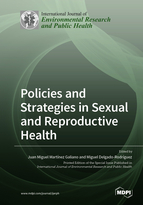Policies and Strategies in Sexual and Reproductive Health
A special issue of International Journal of Environmental Research and Public Health (ISSN 1660-4601). This special issue belongs to the section "Women's Health".
Deadline for manuscript submissions: closed (30 November 2020) | Viewed by 75347
Special Issue Editors
2. Consortium for Biomedical Research in Epidemiology and Public Health (CIBERESP), 28029 Madrid, Spain
Interests: maternal and child health; birth; reproductive sexual health; intimate partner violence; women's health
Special Issues, Collections and Topics in MDPI journals
Special Issue Information
Dear Colleagues,
A thematic collection is being organized on the policies and strategies implemented and to be carried out in sexual and reproductive health. For detailed information on the journal, please refer to https://0-www-mdpi-com.brum.beds.ac.uk/journal/ijerph.
The World Health Organization (WHO) has, as one of its strategic lines of action, sexual and reproductive health (SRH). For this purpose, it carries out a strategic approach to strengthen SRH policies and programs in order to fulfill the ideals of the Millennium Development Goals. In line with this, the WHO has implemented programs, action plans, and strategies on different aspects that are part of the SRH: Global Strategy of the Health Sector against sexually transmitted infections, WHO Recommendations for childbirth care, WHO Maternal Health Program, Recommendations on selected practices for contraceptive use, Responding to intimate partner violence and sexual violence against women, WHO Resolution on female genital mutilation, etc. At present, from different organizations, associations, and scientific societies, an important task is being carried out to adapt the care provided in SRH to care that is marked by scientific evidence and the recommendations based on it. There is an increase in interest, both in research and by clinical professionals, in SRH; this increased interest is found in all disciplines (medicine, nursing, psychology, social work, physiotherapy, etc.) and from all levels of care (primary and specialized), as well as in the approach that is made of this from, including prevention, promotion, treatment and recovery. This thematic collection is open to all topics related to SRH.
Prof. Juan Miguel Martínez Galiano
Prof. Miguel Delgado-Rodríguez
Guest Editors
Manuscript Submission Information
Manuscripts should be submitted online at www.mdpi.com by registering and logging in to this website. Once you are registered, click here to go to the submission form. Manuscripts can be submitted until the deadline. All submissions that pass pre-check are peer-reviewed. Accepted papers will be published continuously in the journal (as soon as accepted) and will be listed together on the special issue website. Research articles, review articles as well as short communications are invited. For planned papers, a title and short abstract (about 100 words) can be sent to the Editorial Office for announcement on this website.
Submitted manuscripts should not have been published previously, nor be under consideration for publication elsewhere (except conference proceedings papers). All manuscripts are thoroughly refereed through a single-blind peer-review process. A guide for authors and other relevant information for submission of manuscripts is available on the Instructions for Authors page. International Journal of Environmental Research and Public Health is an international peer-reviewed open access monthly journal published by MDPI.
Please visit the Instructions for Authors page before submitting a manuscript. The Article Processing Charge (APC) for publication in this open access journal is 2500 CHF (Swiss Francs). Submitted papers should be well formatted and use good English. Authors may use MDPI's English editing service prior to publication or during author revisions.
Keywords
- Sexual and reproductive health
- Sexually transmitted infections
- Birth
- Pregnancy
- Contraception
- Abortion
- Women's Health
- Female genital mutilation
- Prenatal care
- Humanization of childbirth care







